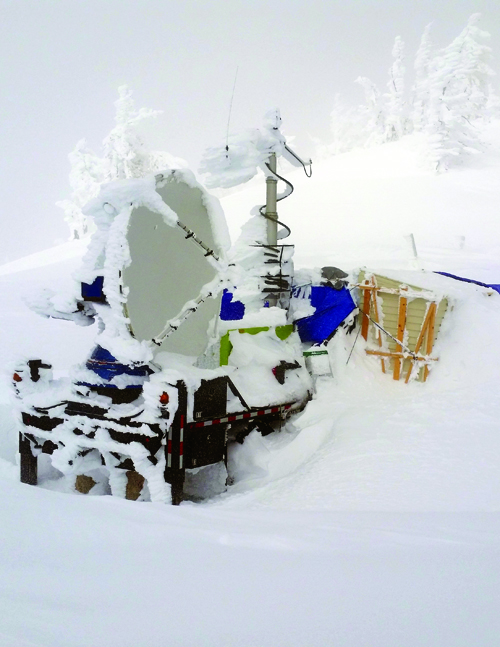Scientists demonstrate that cloud seeding can generate snowfall
Radars, snow gauges confirm seeding increases precipitation under certain conditions
Feb 24, 2020 - by David Hosansky
Feb 24, 2020 - by David Hosansky
Scientists announced today that they have successfully used a combination of radars and snow gauges to measure the impact of cloud seeding on snowfall. The new research addresses decades of speculation about the effectiveness of artificial methods to increase precipitation, demonstrating unambiguously that cloud seeding can boost snowfall across a wide area if the atmospheric conditions are favorable.
"This is a revelation," said Sarah Tessendorf, a scientist at the National Center for Atmospheric Research (NCAR) and co-author of a new paper about the research. "We can definitely say that cloud seeding enhances snowfall under the right conditions."
The researchers, including scientists from the University of Colorado Boulder, University of Wyoming, and University of Illinois at Urbana-Champaign, arrived at their results by analyzing detailed observations taken in a cloud seeding experiment in Idaho during the winter of 2017. They found that injecting clouds with silver iodide generated precipitation at multiple sites at the ground, sometimes creating snowfall where none had existed.
The study provides the most comprehensive evidence to date that cloud seeding can generate rain or snow.
Tessendorf cautioned, however, that successfully producing precipitation requires the presence of clouds. The results are also dependent on such atmospheric factors as local winds. Even when cloud seeding enhances precipitation, there are additional factors that will determine if it is a cost-effective approach to increasing snowpack or replenishing reservoirs.
"The seeding produces ice and that ice can form snow, but is it enough additional snow to make it cost effective?" she asked. "For water managers, the bottom line is the amount of snowpack that you're building over the whole winter and how much runoff it will generate. We are looking into some promising approaches to address those bigger questions, but we still have plenty of work to do to get there."
The study was published this week in Proceedings of the National Academy of Sciences. Funding came from the National Science Foundation (NSF), which is NCAR's sponsor, and from the Idaho Power Company.
As far back as the 1940s, scientists demonstrated that injecting certain types of particles into clouds could induce ice to form and grow around them until they fell out of the clouds.
But measuring what effect, if any, cloud seeding had on measurable rain or snow proved very difficult. Researchers compared the amount of precipitation from randomly seeded clouds with similar clouds that were not seeded, but such statistical analysis produced mixed results, partly because natural precipitation is so variable that it is difficult to pick out the signal from the noise. Other work has indicated that cloud seeding can boost precipitation at specific locations, but left open the question of whether the increase in precipitation extended across significant areas.
To tackle the question, NSF and the Idaho Power Company launched a major field project in the winter of 2017 called SNOWIE (Seeded and Natural Orographic Wintertime clouds — the Idaho Experiment). Researchers used airborne and ground-based radars, high-resolution snow gauges, and computer modeling to quantify the impact of injecting silver iodide into clouds over the Payette Basin region north of Boise. The seeding aircraft released silver iodide along a flight path that resulted in a zigzag pattern of seeding effects in the clouds.

This approach enabled the research team to observe the entire process and compare the side-by-side seeded and unseeded areas.
“We tracked the seeding plume from the time we put it into the cloud until it generated snow that actually fell onto the ground,” said Katja Friedrich, a professor at the University of Colorado Boulder and lead author of the new study.
The results show that, on at least three occasions, the seeding measurably boosted the snowfall across the targeted watershed. A cloud seeding flight on January 19, 2017, for example, generated snow for about 67 minutes, dusting roughly 900 square miles of land with about a tenth of a millimeter of snow above the minimal amount that was falling naturally.
The three cases highlighted in the study produced a combined total of 571 acre feet of water, or the equivalent content of about 285 Olympic-sized swimming pools.
Other cloud seeding attempts, however, were not so easily detected and may not have been successful. Tessendorf said the research team is continuing to analyze 18 additional attempts during SNOWIE in order to learn under what conditions the seeding effect can be detected and result in an increase in precipitation.
The results from SNOWIE can be used to improve computer models of cloud seeding processes and better inform officials as they make decisions about their particular priorities, Tessendorf said. Ski resorts might want to increase snow on selected days, whereas water managers would want to build up snowpack over the course of the winter in order to generate additional spring runoff.
"We're going to need to dig deeper into the data and further quantify the seeding impact," Tessendorf said. "It's important to find out whether this enhances snowpack in a way that meets specific needs. "
Title: Quantifying snowfall from orographic cloud seeding
Authors: Katja Friedrich, Kyoko Ikeda, Sarah A. Tessendorf, Jeffrey R. French, Robert M. Rauber, Bart Geerts, Lulin Xue, Roy M. Rasmussen, Derek R. Blestrud, Melvin L. Kunkel, Nicholas Dawson, and Shaun Parkinson.
Publication: Proceedings of the National Academy of Sciences